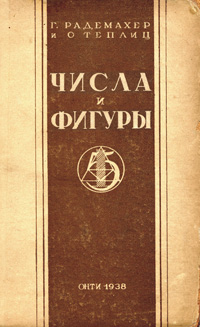
- 1938 Russian edition of "Von Zahlen und Figuren" [The Enjoyment of Mathematics] by Hans Rademacher and Otto Toeplitz
9 Mathematics in Culture
Jewish mathematicians actively contributed to making the intriguing questions of their discipline accessible to a larger public beyond the borders of their scientific community, and to explaining the role of mathematics in general culture. With these goals in mind, Otto Toeplitz, Stefan Cohn-Vossen, Edmund Landau and Hilda Geiringer, to name only a few, all wrote highly successful books, some of which still enjoy great popularity today. These mathematicians were all convinced that it was possible to make every interested person, even those lacking advanced education in mathematics, appreciate contemporary mathematical questions.
Understanding the genesis of mathematical knowledge as a cultural process was an important concern for many of the scholars discussed here. Their point was to demonstrate that mathematics transcended cultural boundaries and that mathematical abilities were inherent in the very nature of human beings.
In 1933, Toeplitz and Hans Rademacher published Von Zahlen und Figuren. Proben mathematischen Denkens für Liebhaber der Mathematik [The Enjoyment of Mathematics: Selections from Mathematics for Amateurs]. The authors were convinced that it is possible to present mathematics in such a way that everybody can enjoy it. By means of carefully selected examples, the authors hoped to show that the aversion to mathematics felt by many disappears if one attempts to present “real mathematics” undisguised.